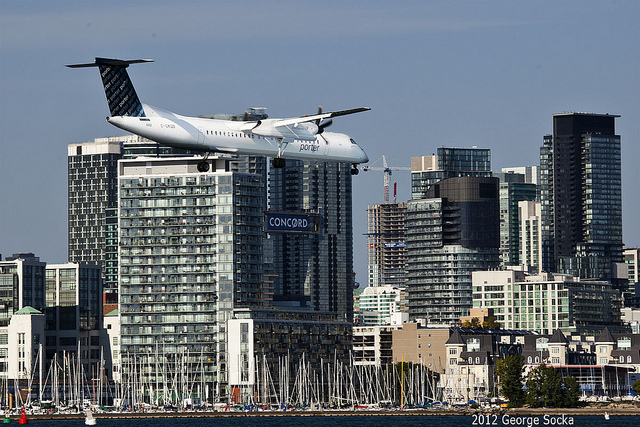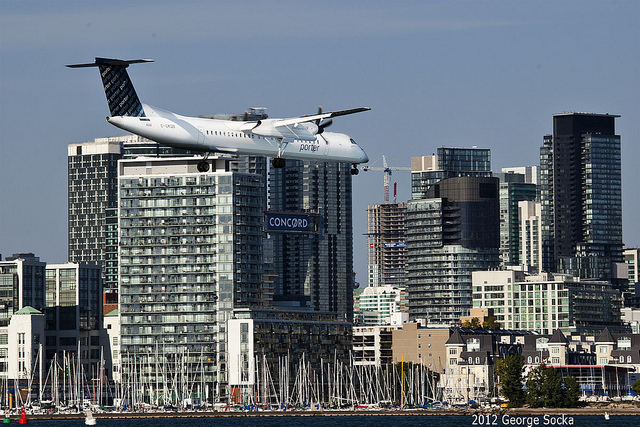
Photo: George Socka CC BY-NC-ND 2.0
Having jets on Toronto’s waterfront may be a thrill for a while, until Torontonians start getting sick. Sure these jets are able to accommodate more passengers and would be a financial windfall for Porter Airlines, but in reality these CS100 jets are an extreme health hazard as Toronto’s air quality is already “beyond a safe threshold” according to Toronto Public Health.
The Tripartite Agreement signed in 1983 by the City of Toronto, the Federal Ministry of Transportation and the Toronto Port Authority (Toronto Harbour Commission at that time), states that there are no jets allowed at Billy Bishop Toronto City Airport (BBTCA).
These jets will more than double the existing flights and takeoffs coming out of BBTCA from 202 daily to 440 according to Gautam Malkani, media co-ordinator for No Jets T.O.
“76 per cent of people flying out of BBTCA are repeat travellers,” said Malkani.
They will create more air pollution on top of existing pollution the waterfront receives from vehicles on the Gardiner Expressway as well as from the industrial buildings that currently exist along our waterfront.
If the expansion of BBTCA goes ahead, which No Jets T.O says will turn it into “Pearson-on-the-lake”, in addition to existing highway traffic Torontonians can look forward to seeing transport trucks that will be carrying hazardous jet fuel which also creates a health risk.
Currently Pearson Airport accommodates 33 million passengers a year, with room to accommodate an additional 7 million according to Carlo Fanelli in Canadian Dimension. Is it worth bringing more traffic to Toronto’s waterfront when there’s already more than enough?
Just because you can’t see it, doesn’t mean it’s not there; this can be said for the black carbon, UPM chemicals and other major toxins such as sulphur dioxide and nitrogen oxide contained in the jet fuel that will be released into our city air by the CS100 jets.
According to the report, Air Pollution Burden of Illness in Toronto, 2004, Toronto sees 1,700 premature deaths and 6,000 hospitalizations due to air pollution every year. Torontonians may not be aware of these alarming statistics.
Community-based physician Dr. Susan Woolhouse, adjunct professor at the Universities of Toronto and Western Ontario says, “jet fuel emissions will not only impact our health but it will also impact climate changes.”
Climate change is definitely something that has already been visible through active weather changes.
The Health Assessment for the Cumulative Air Quality Modelling Study which includes Wards 30 and 32 as well as the South Riverdale and The Beaches neighbourhoods done in 2011, says that of our current air pollution 36 per cent comes from Toronto alone with the remaining 25 per cent generated elsewhere in Ontario and 39 per cent from the United States.
A City of Toronto Report on Air Pollution from Airports, 2008, states that airports are a major contributor to pollution in Toronto, and that the pollution from airports is similar to that emitted from vehicles and industrial sources in the city; associated with chronic respiratory illnesses, cardiovascular illnesses, and premature mortality.
The fact that these are long-term health risks doesn’t mean Torontonians will not see acute illnesses, and pregnant women should also be vigilant as according to Dr. Woolhouse pollution has also been the cause of premature births.
Toronto’s Public Health website states, “Our environment, the air we breathe, the land we walk on and the spaces we spend our time in, impact our health.”
So think about it, bad health is one thing we may not be able to recover from, so why risk it for the thrill of jets in Toronto?


